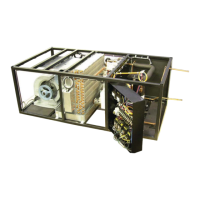21
5.1.4. Flooded System Charging
Flooded systems are units having refrigerant circuits with an optional liquid receiver and head
pressure control valve. When the ambient temperature falls during cold weather, the head pressure
control valve will regulate the fl ow of refrigerant to ensure nearly constant receiver pressure. The
condenser is partially fl ooded with liquid in cold weather. In warm weather the extra refrigerant is
stored in the receiver.
Flooded systems require more refrigerant than fan speed control systems. Connect the pressure
gauge manifold set to the high and low ports near the compressor, connect the charging line to the
refrigerant tank and set it for liquid feed. Open the refrigerant tank valve and purge the line at the
manifold, then open the high side valve on the manifold only and allow the refrigerant fl ow until the
system pressure equalize, at this point the system will have 75 to 80% of the total refrigerant charge.
Start the blower and then the compressor checking the operating pressures and temperatures.
If the unit has a holding charge, before starting a compressor, the crankcase heaters should
be energized for a minimum of 12 hours to reduce the possibility of liquid slugging on start-
up. Failure to energize crankcase heaters could result in compressor damage.
Start the evaporator fan, verify correct fan rotation, then start the compressor. Check the liquid line
sight glass to get a feel for the approximate charge. Bubbles in the sight glass are not unusual at
this point and can be caused by fl ashing from liquid line pressure drop, low subcooling or low charge.
It is likely that more refrigerant will be required to complete the charging procedure.
Adjust the refrigerant charge until the sight glass clears or has only sparse bubbles. The unit should
be allowed to stabilize for several minutes before meaningful measurements can be taken.
If the receiver (head) pressure is below 230 psi, block part of the condenser coil surface until the
pressure rises to 230 psi or higher. During extremely cold weather, all of the condenser fans may
have to be de-energized to maintain 230 psi.
Observe the sight glass on the receiver. Add refrigerant vapor through the suction line until the level
of liquid in the receiver is approximately is the bottom (the leveling ball at
1
/
3
level) of the sight glass
which is at the 80% of circuit charge. Observing the receiver sight glass becomes diffi cult when they
are remote mounted near the condenser.
After the system is allowed to stabilize, the superheat at the compressor suction line at least six
inches away from the compressor should be 8-15
o
F. Units with remote condensing (DRCU) units
the superheat should be 20 to 25
o
F at the compressor, the subcooling will be the same 8 to 10
O
F
as the standard unit. Remove the block from the condenser coil. If the ambient temperature while
charging is below about 60
o
F some of the refrigerant will be backed up in the condenser coil, causing
the liquid level in the receiver to drop.
Note: Charging to a full liquid line sight glass should never be the sole means of
determining the correct refrigerant charge. Other parameters such as superheat, suction
pressure, head pressure, subcooling and ambient temperature are also important
parameters. A system charged to a clear sight glass is often over-charged.

